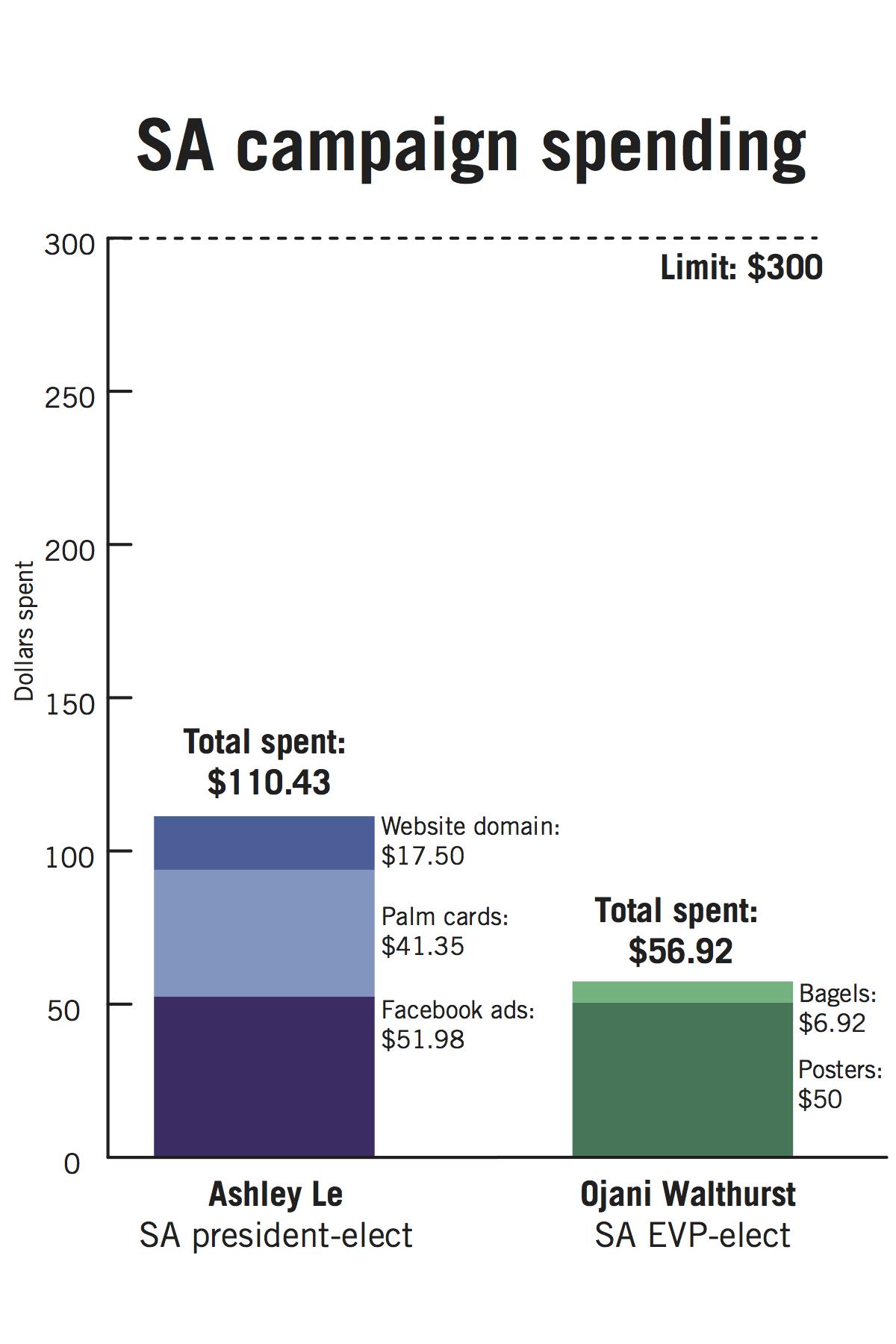
Emily Recko | Staff Designer
Source: Joint Elections Commission
Winners for the Student Association’s top two posts each spent less than $115 on their campaigns this year – the lowest in recent history.
Ashley Le, the SA’s president-elect, spent just $110 on her bid for the position, according to spending forms filed with the Joint Elections Commission – about a quarter of what former SA President Erika Feinman spent on their campaign during the last presidential election in 2016.
Ojani Walthrust, the SA’s executive vice president-elect, dropped about $57 on his campaign – about a quarter of the amount SA President Peak Sen Chua doled out for his successful run for executive vice president last year. Chua became SA president after the presidential race was canceled amid a harassment scandal.
Student leaders said the downward trend in election spending in at least the last four years shows that the SA is making strides to be more accessible to students who may not have the means to dish out hundreds of dollars to launch a campaign.
In 2016, the SA Senate voted to limit election spending to $600 for presidential and executive vice presidential races – down from $1,000 the year before. When the senate overhauled student elections last fall, senators reset the spending cap to just $300 for the top two posts.
Bob Wu, the chairman of the Joint Elections Commission, the body that runs SA elections, said the ability to win a presidential election with $110 in spending “says a lot about affordability” and how students have put an increased focus on driving down the cost of running a campaign in recent years.
“I think it says a lot – $100 is a lot of money in terms of some members of this community, but it’s significantly lower than previous years and I’m glad to see that number go down as the years go on,” he said.
Wu said the JEC did not receive final expenditure forms from former SA presidential candidate Imani Ross or former executive vice presidential candidate Brady Forrest by Friday’s deadline. He said the commission can’t force those candidates to submit spending forms because the only penalty in the JEC’s bylaws is disqualification – which has no effect on candidates who lost.
Ross did not return a request for comment. Forrest said in an email that he spent less than $30 on his campaign, purchasing only Facebook ads and tape. He declined to say why he did not submit his forms to the JEC.
This year is the first in at least the last five election cycles that the losing candidates did not submit expenditure forms to the JEC.
The JEC reforms enacted in the fall allowed candidates to print posters for free in the SA’s Marvin Center office for the first time, which dramatically reduced the amount of money students spent on their campaigns, Wu said.
Candidates for president and executive vice president could print 45 posters – typically among the largest campaign expenditures – for free this year, a perk that came out of the SA’s operating budget, Executive Vice President Sydney Nelson said.
Walthrust spent a total of $57 on his executive vice presidential campaign – $7 on bagels from Panera Bread to give to his volunteers on postering day and $50 on miniature posters printed at the Multicultural Student Services Center.
He said the free printing in the SA office brought down the costs of running off full-sized posters and allowed him to “focus on the design and message of the poster, instead of worrying about how I was going to print it.”
Walthrust said affordability will continue to be a major topic in SA campaigns because lowering costs will allow candidates to think outside of the box to cut their expenses.
“I believe it’s not so much that SA campaigns have become more affordable to run in the recent years, but that students have been able to use what resources they have, even if they are not a lot, to run successful campaigns,” Walthrust said in an email.
Le said she went into the election season aiming to keep her campaign budget small and her ads on Facebook, where most students would interact with her campaign.
“I don’t want you to think that you have to be rich to run for elections, so I made it a priority to keep my budget as low as possible,” she said.
Le spent about $70 combined on Facebook ads and her website domain and roughly $40 on printing costs for palm cards. She said the free printing this year significantly reduced her campaign spending because printing 45 large, color posters at Staples would have cost her another roughly $80 to $85 – and would have almost doubled her expenses.
“I would have easily gone up to $200 or more,” Le said. “I think that poster printing is a huge help, even though it seems like such a small thing.”




